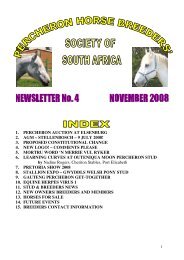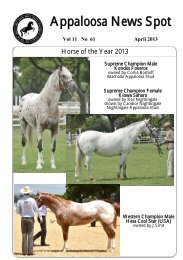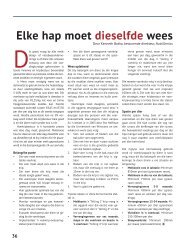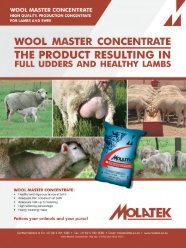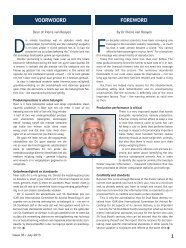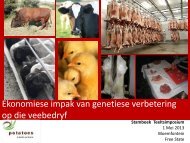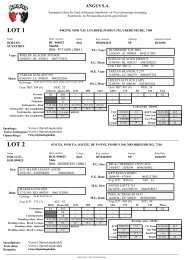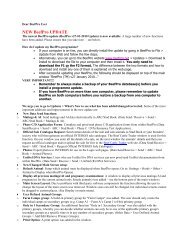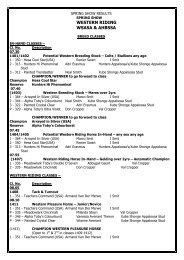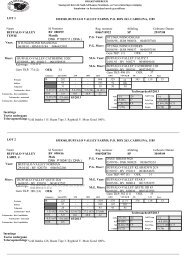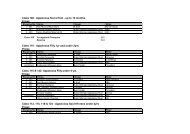Bl/Pg 21
Bl/Pg 21
Bl/Pg 21
Create successful ePaper yourself
Turn your PDF publications into a flip-book with our unique Google optimized e-Paper software.
Crossbreeding<br />
with Beefmasters<br />
Lorenzo Lasator<br />
Isa Cattle Co, Inc in San Angelo Texas<br />
Science and experience have taught us that we can maximize<br />
production efficiency through the use of crossbreeding.<br />
Beefmasters are the ideal breed for beef cattle crossbreeding<br />
programs for a wide range of reasons.<br />
The most important of these, and one unique to Beefmasters,<br />
is our founding philosophy, The Six Essentials (Disposition,<br />
Fertility, Weight, Conformation, Milk Production, and<br />
Hardiness). My Grandfather developed this philosophy<br />
as he developed Beefmasters beginning in the 1930’s. He<br />
did so in an effort to maximize production efficiency in a<br />
challenging environment. Incredibly, the Lasater Philosophy<br />
is as pertinent 80 years later as it was then. This concept is<br />
especially relevant in a crossbreeding program which is<br />
expressly used to produce more beef, more efficiently. This<br />
is without regard to many of the non-economic selection<br />
criteria often employed in a purebred model, such as color,<br />
size, and pedigree.<br />
Tom Lasater, founder of<br />
Beefmaster Breed<br />
Another trait in Beefmasters that makes them perfect<br />
for crossbreeding is that they can easily adapt to nearly<br />
any environment, and still yield the production efficiency<br />
they are famous for. So whether you are in a very cold<br />
environment as is the Foundation Herd on my grandfather’s<br />
ranch in Eastern Colorado, or in the desert or in the tropics,<br />
they will excel. This means that you can cross them on your<br />
existing herd and not be concerned about the adaptability<br />
of the offspring.<br />
Lasater Ranch, Colorado<br />
Something that is tremendously important in considering<br />
Beefmasters in a crossbreeding program is heteroisis or<br />
hybrid vigor. This is simply defined as an increase in the<br />
performance of hybrids over that of purebreds. Because of<br />
their genesis as a 3-breed composite (commonly expressed<br />
as roughly 50% Brahman, 25% Hereford and 25% Shorthorn),<br />
Beefmasters’ built in heteroisis much higher than a straightbred<br />
or two-way cross.<br />
Mating System<br />
Straight breeding 0%<br />
2-breed rotation (A,B) 67%<br />
3-breed rotation (A,B,C) 86%<br />
4-breed rotation (A,B,C,D) 93%<br />
2-breed composite (5/8 A, 3/8 B) 47%<br />
2-breed composite (.5 A, .5 B) 50%<br />
3-breed composite (.5A, .25 B, .25C) 63%<br />
4 breed composite (.25A,.25B,.25C,.25D) 75%<br />
F1 bull rotation (3-breed: AB, AC) 67%<br />
F1 bull rotation (4-breed: AB, CD) 83%<br />
South Florida<br />
% Retained<br />
Heteroisis<br />
As a three breed composite, Beefmasters would have a built<br />
in heterosis of 62.5%. But I maintain it is actually higher than<br />
that, because the “Brahman” in Beefmasters actually refers to<br />
Bos Indicus blood, and that came into the Beefmaster breed<br />
in the form of Nelore cattle from Brazil and Ghir and Guzerat<br />
from India. That would actually put the retained heteroisis in<br />
Beefmasters at somewhere closer to 75%.<br />
What does this actually mean in financial terms? Let’s<br />
say your crossbreeding scheme resulted in about 67%<br />
of maximum heterosis. A 16% increase in the kilos of calf<br />
weaned per cow exposed to breeding is expected above the<br />
B E E F M A S T E R | 2 0 1 2 23



